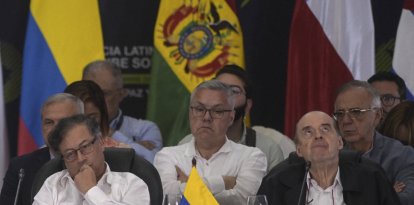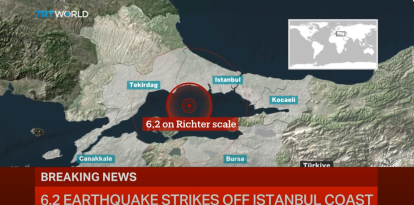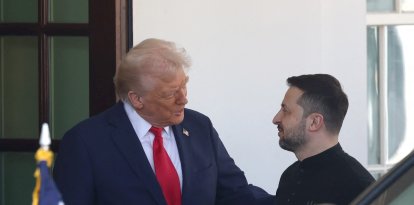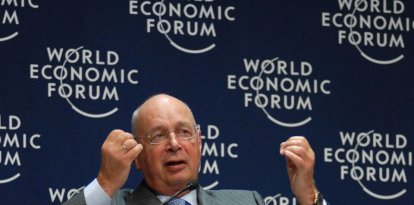Russian invasion of Ukraine 365 days later: no sign of the end
On its first anniversary, the war in Eastern Europe has left thousands of civilians dead and wounded and caused an economic and energy crisis.
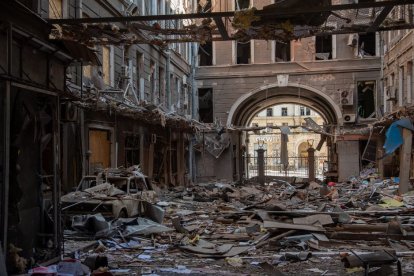
(Cordon Press)
This Friday marks 365 days since the beginning of the Russian invasion of Ukraine. A year later, the aggression continues: anti-aircraft alarms continue to sound on Ukrainian territory and the thunder of bombs had not ceased.
Five days before the first anniversary and without warning, Joe Biden traveled to Kiev to express his unconditional support for Ukraine. The president met with Volodymir Zelensky and informed him of a new $500 million military aid package, in addition to the millions already sent this year. Biden made it clear during his trip through Europe that he will "defend literally every inch of NATO." During the Security Conference in Munich, Germany, Vice President Kamala Harris blamed Russia for committing "crimes against humanity.”
All eyes are also on China. Xi Jinping initially wanted to present himself as a mediator in the conflict. But that claim seems to be fading after sources in the Chinese communist regime confirmed the visit of its president to Moscow. Putin boasted of his collaboration with Xi Jinping, stating that "cooperation between the People's Republic of China and the Russian Federation is of great importance for the stability of the international situation."
Beginning of the invasion
In 2014, Russia stormed the Crimean peninsula, annexing the territory and declaring Donetsk and Luhansk provinces as independent republics. Zelensky's assumption of the Ukrainian presidency further upset Putin, who was watching his Ukrainian neighbors get closer to the West. Because of this, the Russian president deployed his troops to the border shortly before the invasion began.
On Feb. 24, 2022, Vladimir Putin invaded the Dombash region, the Ukrainian territory marking the border between the two countries. Several military fleets landed in port cities such as Odessa or Mariupol, and the bombardment reached Kiev, the capital. Putin then reported via public television that his actions against Ukraine were part of "a special military operation." He went on: "Our plans are not to occupy Ukraine, we do not plan to impose ourselves on anyone.”
Zelenski applied martial law in Ukraine and ordered his troops to mobilize to defend Ukrainian territory:
At the beginning of the invasion, the United States reacted to the advance of the Russian troops. Joe Biden issued a statement in which he held Putin responsible for all casualties and damage:
Thousands of fatalities, injured and refugees
According to the Office of the High Commissioner for Human Rights (OHCHR), the first twelve months of the war left more than 8,000 civilians dead, almost 500 of them children, and more than 13,000 wounded. Gen. Mark Milley, chairman of the U.S. Joint Chiefs of Staff, said some 40,000 civilians have lost their lives in the conflict.
The number of military dead has not been specified. While the Ukrainian Army General Staff put the number of Russian troops killed in combat at more than 140,000, the Russian Defense Ministry estimated that just under 6,000 were killed. On the other side, the Ukrainian government estimated the number of casualties at between 10,000 and 13,000.
The international community activated a plan to take in thousands of Ukrainian families who fled the war. According to OHCHR data, almost a quarter (approximately 8 million citizens) of the total number of people residing in Ukraine were registered in temporary protection programs or similar national protection programs in Europe. In the United States, Joe Biden announced the Uniting for Ukraine program, pledging to take in some 100,000 Ukrainians. To date, approximately 2,000 have been accepted by the Biden administration.
Economic impact and energy crisis
Apart from the fatalities, injuries and refugees, serious damage had been done to the global economy. The prices of products exported by Russia, which many European Union countries depend on, soared, directly affecting families and consumers.
In terms of energy, Russia applied cuts in the supply of natural gas to Germany and France. In August, Putin shut down the Nordstream 1 pipeline, which transports hydrocarbon from Russia to Germany via the Baltic Sea.
Military dispatch by the international community and corruption in Ukraine
Zelensky's main ask in these 365 days has been for military support. In late January, Biden announced the shipment of 31 M1 Abrams battle tanks. On the other hand, German Chancellor Olaf Scholz announced the transfer of 14 Leopard 2 battle tanks, as well as ammunition and logistical support.
The Ukrainian president wants more. He knows that in order to defeat Russia, Ukraine will need better military equipment than it currently has at its disposal. A day after learning of Biden's announcement, Zelensky's government asked the international community for F-16 fighter jets from the international community. The U.S. has no plans to send this type of weaponry at this time.
Between the alarms and explosions, Zelensky has had another problem. At the end of January, the Ukrainian president announced several dismissals and resignations in some of the most important positions in his cabinet. These decisions were linked to allegations of corruption.
RECOMMENDATION

